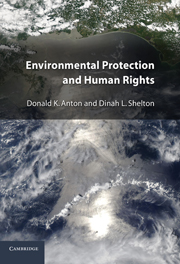Book contents
- Frontmatter
- Contents
- Acknowledgments
- Abbreviations
- Table of Cases
- 1 Law and the Environment
- 2 The Environment as a Human Rights Issue
- 3 An Introduction to Human Rights Origins and Theory
- 4 The International Protection of Human Rights
- 5 International Human Rights Institutions and Procedures
- 6 Procedural Human Rights and the Environment
- 7 Substantive Human Rights and the Environment
- 8 Indigenous Peoples, Rights, and the Environment
- 9 Humanitarian Crises: Armed Conflicts and Other Disasters
- 10 Environmental Rights and International Finance: The World Bank Example
- 11 Human Rights, the Environment, and Corporate Accountability
- Index
8 - Indigenous Peoples, Rights, and the Environment
Published online by Cambridge University Press: 05 June 2012
- Frontmatter
- Contents
- Acknowledgments
- Abbreviations
- Table of Cases
- 1 Law and the Environment
- 2 The Environment as a Human Rights Issue
- 3 An Introduction to Human Rights Origins and Theory
- 4 The International Protection of Human Rights
- 5 International Human Rights Institutions and Procedures
- 6 Procedural Human Rights and the Environment
- 7 Substantive Human Rights and the Environment
- 8 Indigenous Peoples, Rights, and the Environment
- 9 Humanitarian Crises: Armed Conflicts and Other Disasters
- 10 Environmental Rights and International Finance: The World Bank Example
- 11 Human Rights, the Environment, and Corporate Accountability
- Index
Summary
Introduction
Indigenous peoples are uniquely vulnerable to environmental harm because of the increasing pressures on their lands and resources, as well as the cultural and religious links they maintain with their ancestral territories. There are more than 200 million indigenous people in the world. Most of them live in highly vulnerable ecosystems: the Arctic and tundra, tropical and boreal forests, riverine and coastal zones, and mountains and semiarid rangelands. In the past few decades, traditional indigenous lands have come under increased pressure as outsiders have sought and extracted or converted natural resources to supply a growing global demand. Once hardly accessible, the territories used and occupied by indigenous peoples have become a major source of hydroelectric power, minerals, hardwoods, and pasture lands. Other indigenous regions are being threatened or lost as a result of climate change, as discussed in Chapter 9. For those indigenous and tribal peoples who have remained in their traditional territories, the invasion of the outside world has brought with it disease; exploitation; loss of language and culture; and in too many instances, complete annihilation of the group as a distinct entity. For reports of the U.N. special rapporteur on indigenous peoples, see U.N. Docs. A/HRC/15/37 (2010); A/HCC/12/34 (2009); A/HRC/9/9 (2008); A/HRC/4/32 (2007).
This chapter begins by examining the theoretical approaches to the rights of indigenous peoples. It then looks at the relevant international legal texts before turning to international and domestic jurisprudence.
- Type
- Chapter
- Information
- Environmental Protection and Human Rights , pp. 545 - 665Publisher: Cambridge University PressPrint publication year: 2011



